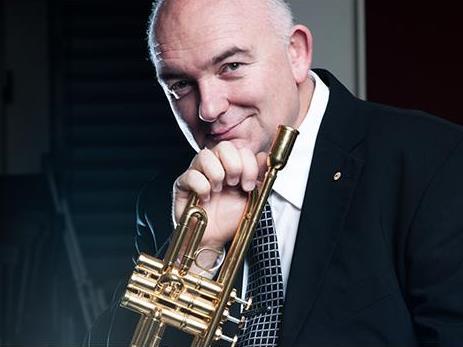James Morrison. Image via jamesmorrison.com.
Jazz! What a powerful four-letter word that no amount of words can aptly describe. Maybe the two zeds give a clue when you consider the feelings that go with buzz, fizz, zing or sizzle.
But what exactly is the magic of James Morrison, the master of this genre, who has been playing jazz in front of orchestras since the age of 15 years? Nearly half a century and still he’s welcomed to packed houses all over the world. Rather than a solo artist who appears on stage to play one instrument for, perhaps, 40 minutes, he will play upwards of ten different instruments, including piano, for close to two hours. Not only can that include synchronising with eighty plus musicians in the orchestra, but also delivering mind-blowing, often highly amusing, trivia about jazz at the same time.
The word, magic, however, usually conjures up making things disappear and, in a sense, that is what Morrison does when he reproduces a melody in his own unique way, not unlike vocal improvisation called scat singing.
In this concert, before playing each of the thirteen melodies written between the 1920s and 1950s and reproduced in The Great American Songbook, Morrison goes to some length to explain how the melody came about and how differently it might have been delivered by subsequent musicians. As an example he demonstrated the use of muliphonics, or the playing of two notes at once, in a playful archipelago of Duke Ellington’s ‘Don’t Get Around Much Any More’ between ‘answering himself’ on the trombone and his son, Harry, doing the same, on double bass. While the melody may disappear briefly like this or in a flurry of notes that may not be defined, what Morrison is also saying is something far more important. It is explained in the mantra he espouses for potential students of the Jazz Academy which he established in Mt Gambier in 2015. It is simply that, while education is necessary to understand the dynamics behind a complicated tune, it is essential for a musician is to be able to release him/herself from any constrictions in that education in order to find the freedom to deliver the music with passion from within.
Great music may, superficially, be classified as either classical or jazz but this is probably one of the greatest errors of judgement made in pursuit of education about music, particularly jazz. Many great jazz musicians, like George Gershwin have wanted their music accepted as classical and many classical composers, like Stravinsky, have collaborated with jazz musicians.
It was clear in this concert that a symphony orchestra can adapt seamlessly with a brilliant jazz musician even if it became so enthusiastic introducing ‘A Foggy Day in London Town’ that it almost caused Morrison’s trumpet to tremble. However, the gentle production of tunes like ‘A Time for Love’ on trombone and ‘Every Time we say Goodbye’ on bass saxophone, with Harp accompaniment, soon brought back the balance needed to the program.
Morrison’s addition of his Quartet, to the right side front of the stage, added another dimension to the evening. Made up of his two sons, William on Bass Guitar and Harry on Double Bass plus Patrick Danao, a graduate of the Jazz Academy, on drums, the combination was exquisite in arrangements for ‘Tenderly’ accompanying Morrison on Flugelhorn and ‘The Shadow of your Smile,’ when he switched to piano and then bass saxophone after a beautiful introduction by the Chief Violinist.
As Morrison said at the start it was a ‘feast of a program’ and the audience was unwilling to let him go so he turned a final trick to get his point across about jazz by giving Duke Ellington’s answer to the endless question,‘What is Jazz?’ and played, ‘It Don’t Mean a Thing if You Ain’t Got that Swing!’
Morrison has played before royalty and Presidents, and been awarded many accolades. Perhaps it’s time he was recognised as one of Australia’s National Living Treasures like his great mentor, Don Burrows.
Rating: 4 ½ stars ★★★★☆
James Morrison with WASO: The Great American Songbook
JAMES MORRISON with WASO
The Great American Songbook
West Australian Symphony Orchestra
3 August, 2018
Perth Concert Hall





